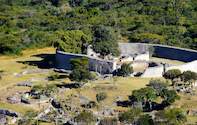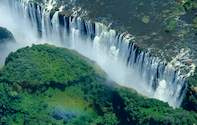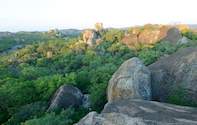
Zimbabwe Has Five UNESCO World Heritage Sites
- Mana Pools (Natural)
- Khami Ruins National Monument (Cultural)
- Great Zimbabwe Ruins (Cultural)
- Mosi-oa-Tunya / Victoria Falls (Natural)
- Matobo Hills (Cultural)
Mana Pools - Date of Inscription 1984

Mana Pools, one of the World Heritage Sites in Zimbabwe, is a wildlife conservation area and consists of three different areas: Mana Pools National Park and the Sapi and Chewore Safari Areas. Situated in the Zambezi valley, this is a remote and spectacular area with magnificent views of the Zambezi River and mountains of the Rift Valley over in Zambia.
Mana means “four” in Shona which are the Main, Chine, Long and Chisambuk pools. Mana Pools is among the least developed National Parks in Zimbabwe but is renowned for its game-viewing. Large concentrations of buffalo and elephant are found along the river's edges, while predators such as lions, wild dogs, leopards, hyenas and cheetah are often sighted. Greater kudu, Burchell's zebra, impala, warthog and common waterbuck can be seen on the plains. Mana Pools offers fantastic birding with over 300 species recorded.
Game viewing at Mana Pools can be done on boat safaris, game drives and bush walks. Fishing and canoeing are popular activities too. The best time of year to visit Mana Pools is between May and October, as large groups of animals congregate along the river to drink as water elsewhere in the park is scarce. When the rainy season starts (November) it becomes exceptionally hot and the roads can become impassable.
Visit Mana Pools National Park Safari Lodges in Zimbabwe
Great Zimbabwe - Date of Inscription 1986
The Great Zimbabwe ruins with its massive curving walls, constructed from millions of granite blocks fitted together without mortar, hosts the largest stone structures south of the pyramids.
Great Zimbabwe, which means "houses of stone", is an ancient city situated 30 kilometers from Masvingo, Zimbabwe. Awe inspiring, majestic and timeless, these structures were built by indigenous African people between AD 1250 and AD 1450. At the height of its power, Great Zimbabwe had over 18,000 inhabitants. Great Zimbabwe was a main trading center and associated with gold trading. Fragments of Persian and Chinese pottery have also been found at this ancient site.
The two main enclosures are the Hill Complex, on the steep-sided granite hill and the land below this hill where the Valley Enclosures and the Great Enclosure are situated. The stone walls, up to six meters thick and twelve meters high, are built of granite blocks without the use of mortar.
Travel Guide to Great Zimbabwe
Mosi-oa-tunya / Victoria Falls - Date of Inscription 1989

Victoria Falls is one of the natural World Heritage Sites in Zimbabwe and one of the most spectacular waterfalls in the world. The Victoria Falls are 1708m wide and drop 99m at its highest point, making it the largest sheet of falling water in the world when the Zambezi River is at its fullest. Twice the height of Niagara Falls and one and a half times wider, the Victoria Falls are divided into five separate waterfalls: Devil's Cataract, Main Falls, Horseshoe Falls, Rainbow Falls and Eastern Cataract.
Victoria Falls (also known as Mosi-oa-Tunya, "the smoke that thunders") seen by David Livingstone, the first European to see the falls, named it in honour of Queen Victoria. He was so impressed by what he saw that he described the falls saying "scenes so lovely must have been gazed upon by angels in their flight."
Peak floodwaters usually occur during April when approximately 625 million litres per minute cascade over the edge per minute. The resulting spray rises up to 1650 feet into the air that can be seen more than 20 km away. During this time there is so much water flowing that the spray makes it quite difficult to see the falls.
Mosi-oa-Tunya National Park is home to the spectacular Victoria Falls. Mosi-oa-Tunya National Park is situated in the southernmost edge of Zambia with Zimbabwe on its border. The Victoria Fall is the physical landmark that separates these two countries. The park is a wildlife sanctuary and animals found here are white rhino, giraffe, elephant, buffalo, impala, puku, and warthog. Travellers to Victoria Falls can enjoy thrilling adventure activities including white water rafting, bungee jumping, river cruises, fishing and game drives.
Visit Victoria Falls Hotels, Resorts and Safari Lodges on the Zimbabwean Side
Khami Ruins National Monument - Date of Inscription 1986
The Khami Ruins are the second most important archaeological site in Zimbabwe after the Great Zimbabwe Ruins. Khami developed and grew between 1450 and 1650 after the capital of Great Zimbabwe had been abandoned.
Both ruins belonged to the same cultural tradition and have the same layout in sectors, between the chief's residence and an open area with huts for the majority of the population. Imported goods like Ming porcelain and Spanish silverware were found, which shows that Khami was a major centre for trade over a long period of time.
The Khami Ruins, one of the World Heritage Sites in Zimbabwe, are a national monument and are an impressive but unknown attraction in Zimbabwe.
Matobo Hills - Date of Inscription 2003

The Matobo Hills, another of the World Heritage Sites in Zimbabwe, are home to an outstanding collection of rock paintings, the largest in southern Africa. The large boulders provide abundant natural shelters and have been associated with human occupation from the early Stone Age.
The Matobo Hills and caves of the area are renowned for the 20,000 cave paintings and petroglyphs that can be found there, which date from as far back as 13,000 years ago. The unusual hill formations that dot the landscape are called “Bald Heads” by the local people.
The various themes depicted in the paintings are associated with hunting and gathering and compared to Tsodilo in Botswana, the Matobo Hills are older and associated with a different cultural tradition. The Matobo Hills still provide a strong focus for the local Zimbabwe community, which use the shrines and sacred places linked to traditional and social activities.
Visit Matobo National Park Safari Lodges in Zimbabwe
Tentative list for Zimbabwe - Ziwa National Monument
The Ziwa National Monuments bear evidence of human occupation for all the major archaeological periods identified in Zimbabwe's history. Starting from the hunter-gatherer periods of the Stone Age to historical times, the following has been found in the vicinity - Stone Age deposits; rock art sites; landscapes of farming communities marked by terraces and field systems, hill forts, pit structures and stone enclosures; iron smelting and forging furnaces and numerous remains of daub-plastered housing structure.

 No visit to Zimbabwe is complete without a visit to the Great Zimbabwe Ruins. During a tour of the ruins visitors can explore the incredible...
No visit to Zimbabwe is complete without a visit to the Great Zimbabwe Ruins. During a tour of the ruins visitors can explore the incredible... Zimbabwe safari guide - Thinking about going to Zimbabwe on holiday or safari ? Here are some reasons why you should visit Zimbabwe....
Zimbabwe safari guide - Thinking about going to Zimbabwe on holiday or safari ? Here are some reasons why you should visit Zimbabwe....